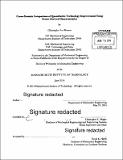Cross-domain comparison of quantitative technology improvement using patent derived characteristics
Author(s)
Benson, Christopher Lee
DownloadFull printable version (49.51Mb)
Other Contributors
Massachusetts Institute of Technology. Department of Mechanical Engineering.
Advisor
Christopher L. Magee.
Terms of use
Metadata
Show full item recordAbstract
This thesis compares the performance improvement rates of 28 technological domains with characteristics derived from the patents of the domains, seeking to objectively test theories of how and why technologies change over time. Performance metrics for 28 technological domains were tracked over time and showed exponential improvement. Each of the 28 domains increases at a different exponential technological improvement rate (the annual percentage increase in performance). These improvement rates vary substantially, including the ~36% annual improvement of Moore's Law (doubling ever 2 years) and the ~3.4% yearly improvement in electrochemical battery specific energy storage. A set of patents is selected for each domain and analyzed using patent based markers that are designed to test hypotheses of technological change. We find that the best indicator of a high improvement rate for a technology is the average number of citations that the patents in that domain receive within the first 3 years after publication, with a Pearson correlation coefficient of 0.74. This, along with several of the other tests support the hypothesis that domains whose patents are more highly cited patents are published more recently on average are likely to improve more rapidly. These measures are combined into a predictive model that can be used to accurately estimate the technological improvement rates of a domain using only patent data. A measure of reliance on basic science, the average ratio of non-patent literature citations to overall citations, did not show a correlation with improvement rate. Additionally, our data does not show a correlation between the number of patents issued and the improvement rate in a domain, however we show that patents can be used as an effort variable when compared with the functional performance metrics of a technology. By study of multiple effort variables, we find evidence to support time as the fundamental variable for which technological performance should be measured against. This is not in support of production-based theories such as Wright's Law. Ultimately the thesis provides a falsifiable quantitative and qualitative method to test how and why different technologies improve over time.
Description
Thesis: Ph. D., Massachusetts Institute of Technology, Department of Mechanical Engineering, 2014. Cataloged from PDF version of thesis. Includes bibliographical references (pages 373-381).
Date issued
2014Department
Massachusetts Institute of Technology. Department of Mechanical EngineeringPublisher
Massachusetts Institute of Technology
Keywords
Mechanical Engineering.